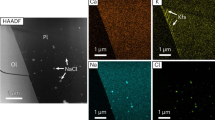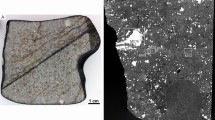Abstract
Carbonaceous chondrite meteorites record the earliest stages of Solar System geological activities and provide insight into their parent bodies’ histories. Some carbonaceous chondrites are volumetrically dominated by hydrated minerals, providing evidence for low-temperature, low-pressure aqueous alteration1. Others are dominated by anhydrous minerals and textures that indicate high-temperature metamorphism in the absence of aqueous fluids1. Evidence of hydrous metamorphism at intermediate pressures and temperatures in carbonaceous chondrite parent bodies has been virtually absent. Here we show that an ungrouped, aqueously altered carbonaceous chondrite fragment (numbered 202) from the Almahata Sitta (AhS) meteorite contains an assemblage of minerals, including amphibole, that reflect fluid-assisted metamorphism at intermediate temperatures and pressures on the parent asteroid. Amphiboles are rare in carbonaceous chondrites, having only been identified previously as a trace component in Allende (CV3oxA) chondrules2. Formation of these minerals would require prolonged metamorphism in a large (about 640–1,800 kilometres in diameter) asteroid that is as yet unknown. Because Allende and AhS 202 represent different asteroidal parent bodies, intermediate conditions may have been more widespread in the early Solar System than is recognized from known carbonaceous chondrite meteorites, which are likely to represent a biased sampling.
This is a preview of subscription content, access via your institution
Access options
Access Nature and 54 other Nature Portfolio journals
Get Nature+, our best-value online-access subscription
$29.99 / 30 days
cancel any time
Subscribe to this journal
Receive 12 digital issues and online access to articles
$119.00 per year
only $9.92 per issue
Buy this article
- Purchase on Springer Link
- Instant access to full article PDF
Prices may be subject to local taxes which are calculated during checkout



Similar content being viewed by others
Data availability
The data shown in this paper are available from the corresponding author upon reasonable request.
References
Brearley, A. J. & Jones, R. H. in Planetary Materials (ed. Papike, J. J.) Ch. 3 (Mineralogical Society of America, 1998).
Brearley, A. J. Disordered biopyriboles, amphibole, and talc in the Allende meteorite: products of nebular or parent body aqueous alteration? Science 276, 1103–1105 (1997).
Jenniskens, P. et al. The impact and recovery of asteroid 2008 TC3. Nature 458, 485–488 (2009).
Shaddad, M. H. et al. The recovery of asteroid 2008 TC3. Meteorit. Planet. Sci. 45, 1557–1589 (2010).
Horstmann, M. & Bischoff, A. The Almahata Sitta polymict breccia and the late accretion of asteroid 2008 TC3. Chem. Erde 74, 149–183 (2014).
Goodrich, C. A. et al. Origin and history of ureilitic material in the solar system: the view from asteroid 2008 TC3 and the Almahata Sitta meteorite. Meteorit. Planet. Sci. 50, 782–809 (2015).
Downes, H., Mittlefehldt, D. W., Kita, N. T. & Valley, J. W. Evidence from polymict ureilite meteorites for a disrupted and re-accreted single ureilite parent asteroid gardened by several distinct impactors. Geochim. Cosmochim. Acta 72, 4825–4844 (2008).
Patzek, M., Pack, A., Bischoff, A., Visser, R. & John, T. Mineralogy of volatile-rich clasts in brecciated meteorites. Meteorit. Planet. Sci. 53, 2519–2540 (2018).
Goodrich, C. A. et al. Carbonaceous chondrite-like xenoliths in polymict ureilites: a large variety of unique outer solar system materials. Lunar Planet. Sci. Conf. 50, 1312 (2019).
Fioretti, A. et al. A report on 63 newly sampled stones of the Almahata Sitta fall (asteroid 2008 TC3) from the University of Khartoum collection, including a C2 carbonaceous chondrite. Lunar Planet. Sci. Conf. 48, 1846 (2017).
Goodrich, C. A. et al. The Almahata Sitta polymict ureilite from the University of Khartoum collection: Classification, distribution of clast types in the strewn field, new meteorite types, and implications for the structure of asteroid 2008 TC3. Lunar Planet. Sci. Conf. 49, 1321 (2018).
Christensen, P. R. et al. A thermal emission spectral library of rock-forming minerals. J. Geophys. Res. 105, 9735–9739 (2000).
Brearley, A. J. in Meteorites and the Early Solar System II (eds Lauretta, D. S. & McSween, H. Y. Jr) 587–624 (Univ. Arizona Press, 2006).
Hamilton, V. E. et al. Discovery of abundant tremolite in a carbonaceous chondrite fragment from the Almahata Sitta meteorite. Lunar Planet. Sci. Conf. 51, 1122 (2020).
Ikeda, Y. An overview of the research consortium, “Antarctic carbonaceous chondrites with CI affinities, Y-86720, Y-82162, and B-7904”. In Proc. Sixteenth Symposium on Antarctic Meteorites (eds Yanai, K. et al.) 49–73 (NIPR, 1992).
Tonui, E. et al. Petrographic, chemical and spectroscopic evidence for thermal metamorphism in carbonaceous chondrites I: CI and CM chondrites. Geochim. Cosmochim. Acta 126, 284–306 (2014).
Geiger, T. & Bischoff, A. Formation of opaque minerals in CK chondrites. Planet. Space Sci. 43, 485–498 (1995).
Huss, G. R., Rubin, A. E. & Grossman, J. N. in Meteorites and the Early Solar System II (eds Lauretta, D. S. & McSween, H. Y. Jr) 567–586 (Univ. Arizona Press, 2006).
McCanta, M. et al. The LaPaz Icefield 04840 meteorite: mineralogy, metamorphism, and origin of an amphibole- and biotite-bearing R chondrite. Geochim. Cosmochim. Acta 72, 5757–5780 (2008).
Gross, J., Treiman, A. H. & Connolly Jr., H. C. A new subgroup of amphibole-bearing R chondrites: evidence from the new R-chondrite MIL 11207. Lunar Planet. Sci. Conf. 44, 2212 (2013).
Sears, D. W. G. The case for rarity of chondrules and calcium-aluminum-rich inclusions in the early solar system and some implications for astrophysical models. Astrophys. J. 498, 773–778 (1998).
Flynn, G. J., Consolmagno, G. J., Brown, P. & Macke, R. J. Physical properties of the stone meteorites: implications for the properties of their parent bodies. Chem. Erde 78, 269–298 (2018).
Hamilton, V. E. et al. Evidence for widespread hydrated minerals on asteroid (101955) Bennu. Nat. Astron. 3, 332–340 (2019).
Kitazato, K. et al. Surface composition of asteroid 162173 Ryugu as observed by the Hayabusa2 NIRS3 instrument. Science 364, 272–275 (2019).
Simon, A. A. et al. Widespread distribution of carbon-bearing materials on near-Earth asteroid (101955) Bennu. Science 370, eabc352 (2020).
Kaplan, H. H. et al. Bright carbonate veins on asteroid (101955) Bennu: implications for aqueous alteration history. Science 370, eabc3557 (2020).
Salisbury, J. W., D'Aria, D. M. & Jarosewich, E. Midinfrared (2.5–13.5 µm) reflectance spectra of powdered stony meteorites. Icarus 92, 280–297 (1991).
Ruff, S. W., Christensen, P. R., Barbera, P. W. & Anderson, D. L. Quantitative thermal emission spectroscopy of minerals: a laboratory technique for measurement and calibration. J. Geophys. Res. 102, 14899–14913 (1997).
Hamilton, V. E. Spectral classification of ungrouped carbonaceous chondrites. I. Data collection and processing. Lunar Planet. Sci. 49, 1759 (2018).
Rogers, A. D. & Aharonson, O. Mineralogical composition of sands in meridiani planum determined from mars exploration rover data and comparison to orbital measurements. J. Geophys. Res. 113, E06S14 (2008).
Hamilton, V. E., Haberle, C. W. & Mayerhöfer, T. G. Effects of small crystallite size on the thermal infrared (vibrational) spectra of minerals. Am. Mineral. 105, 1756–1760 (2020).
Hamilton, V. E., Christensen, P. R. & McSween, H. Y. Jr. Determination of Martian meteorite lithologies and mineralogies using vibrational spectroscopy. J. Geophys. Res. 102, 25593–25603 (1997).
Hawthorne, F. et al. IMA report, nomenclature of the amphibole supergroup. Am. Mineral. 97, 2031–2048 (2012).
Locock, A. J. An Excel spreadsheet to classify chemical analyses of amphiboles following the IMA 2012 recommendations. Comput. Geosci. 62, 1–11 (2014).
Bucher, K. & Grapes, R. Petrogenesis of Metamorphic Rocks 8th edn (Springer, 2011).
Powell, R. & Holland, T. An internally consistent dataset with uncertainties and correlations. 3. Applications to geobarometry, worked examples and a computer program. J. Metamorph. Geol. 6, 173–204 (1988).
Holland, T. & Powell, R. An improved and extended internally consistent thermodynamic dataset for phases of petrological interest, involving an new equation of state for solids. J. Metamorph. Geol. 29, 333–383 (2011).
Pawley, A. R., Graham, C. M. & Navrotsky, A. Tremolite-richterite amphiboles: synthesis, compositional and structural characterization, and thermochemistry. Am. Mineral. 78, 23–35 (1993).
Maresch, W. V. & Czank, M. Crystal chemistry, growth kinetics and phase relationships of structurally disordered (Mn2+,Mg)-amphiboles. Fortschr. Mineral. 66, 69–121 (1988).
Macke, R. J., Consolmagno, G. J. & Britt, D. T. Density, porosity, and magnetic susceptibility of carbonaceous chondrites. Meteorit. Planet. Sci. 46, 1842–1862 (2011).
Acknowledgements
V.E.H., C.A.G. and M.E.Z. are supported by grant 80NSSC19K0507 from NASA’s Emerging Worlds programme. M.E.Z. was also supported by the Hayabusa2 Participating Scientist Program (NASA). A. Fioretti initially recognized and selected AhS 202 for analysis, made the mount and collected early scanning electron microscopy observations. We thank J. Filiberto (LPI/USRA) for contributing to scientific discussions. The Lunar and Planetary Institute (LPI) is operated by Universities Space Research Association (USRA) under a cooperative agreement with the Science Mission Directorate of NASA. This is LPI Contribution no. 2546.
Author information
Authors and Affiliations
Contributions
V.E.H. conducted and analysed the spectral measurements, contributed to the scientific interpretation, and coordinated and wrote the manuscript. C.A.G. conducted and analysed the scanning electron microscopy and EMPA measurements, performed the parent-body size modelling, and contributed to the scientific interpretation of all data. A.H.T. contributed to the metamorphic mineral assemblage modelling and textural interpretations. H.C.C. contributed to the scientific interpretation of the observed EPMA, textural and spectral results. M.E.Z. conducted EMPA and TEM measurements and contributed to the scientific interpretation of those data. M.H.S. provided the sample of AhS 202 from the University of Khartoum collection.
Corresponding author
Ethics declarations
Competing interests
The authors declare no competing interests.
Additional information
Peer review information Nature Astronomy thanks Jemma Davidson and the other, anonymous, reviewer(s) for their contribution to the peer review of this work.
Publisher’s note Springer Nature remains neutral with regard to jurisdictional claims in published maps and institutional affiliations.
Supplementary information
Supplementary Information
Supplementary Tables 1–3 and Figs. 1–3.
Rights and permissions
About this article
Cite this article
Hamilton, V.E., Goodrich, C.A., Treiman, A.H. et al. Meteoritic evidence for a Ceres-sized water-rich carbonaceous chondrite parent asteroid. Nat Astron 5, 350–355 (2021). https://doi.org/10.1038/s41550-020-01274-z
Received:
Accepted:
Published:
Issue Date:
DOI: https://doi.org/10.1038/s41550-020-01274-z



